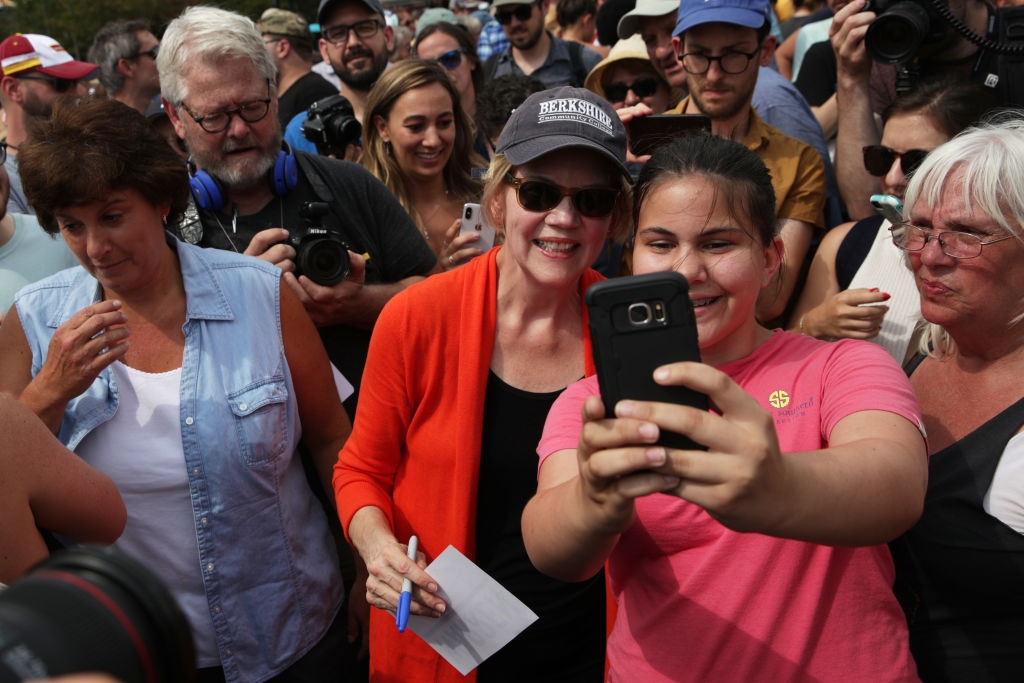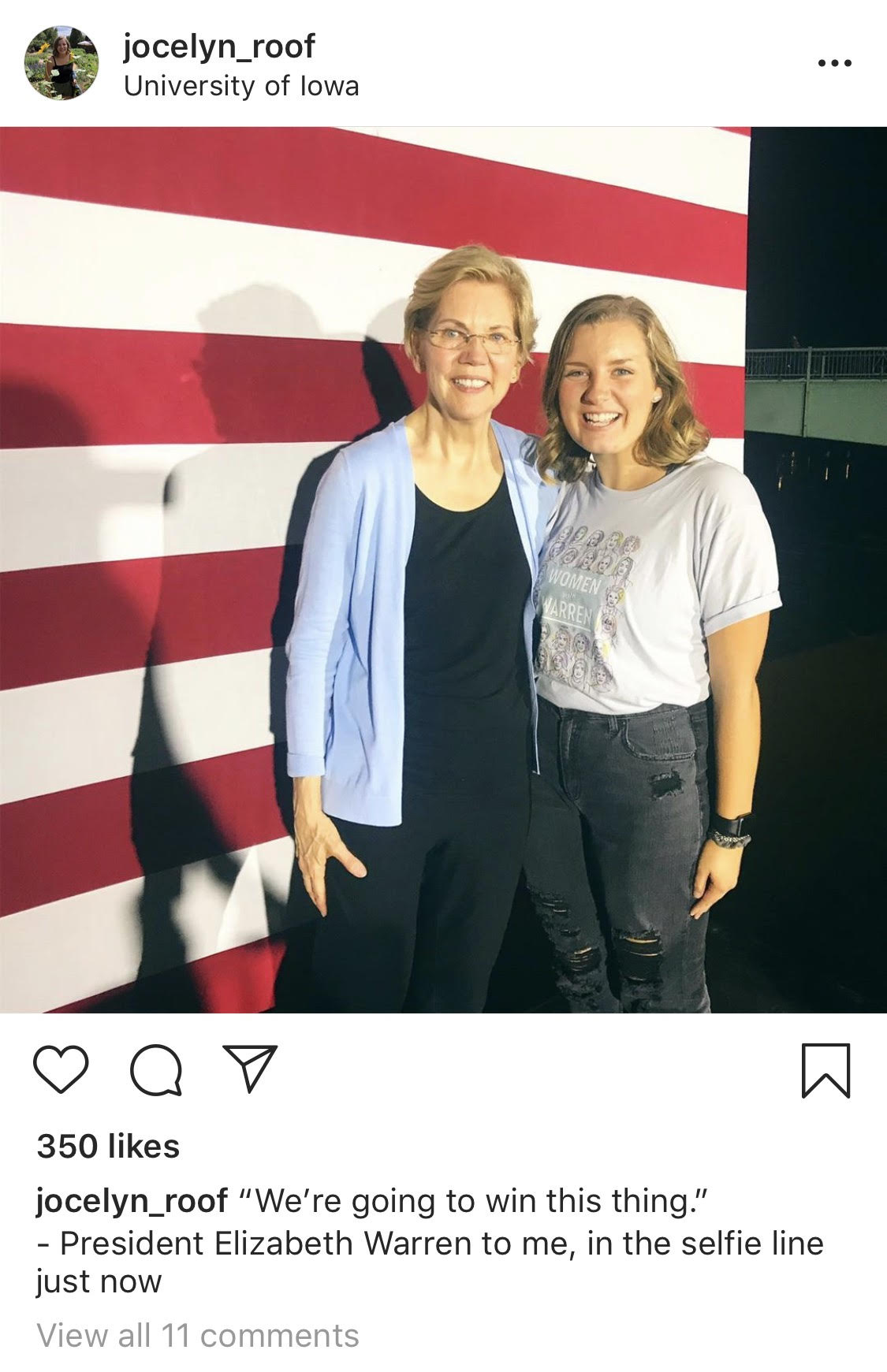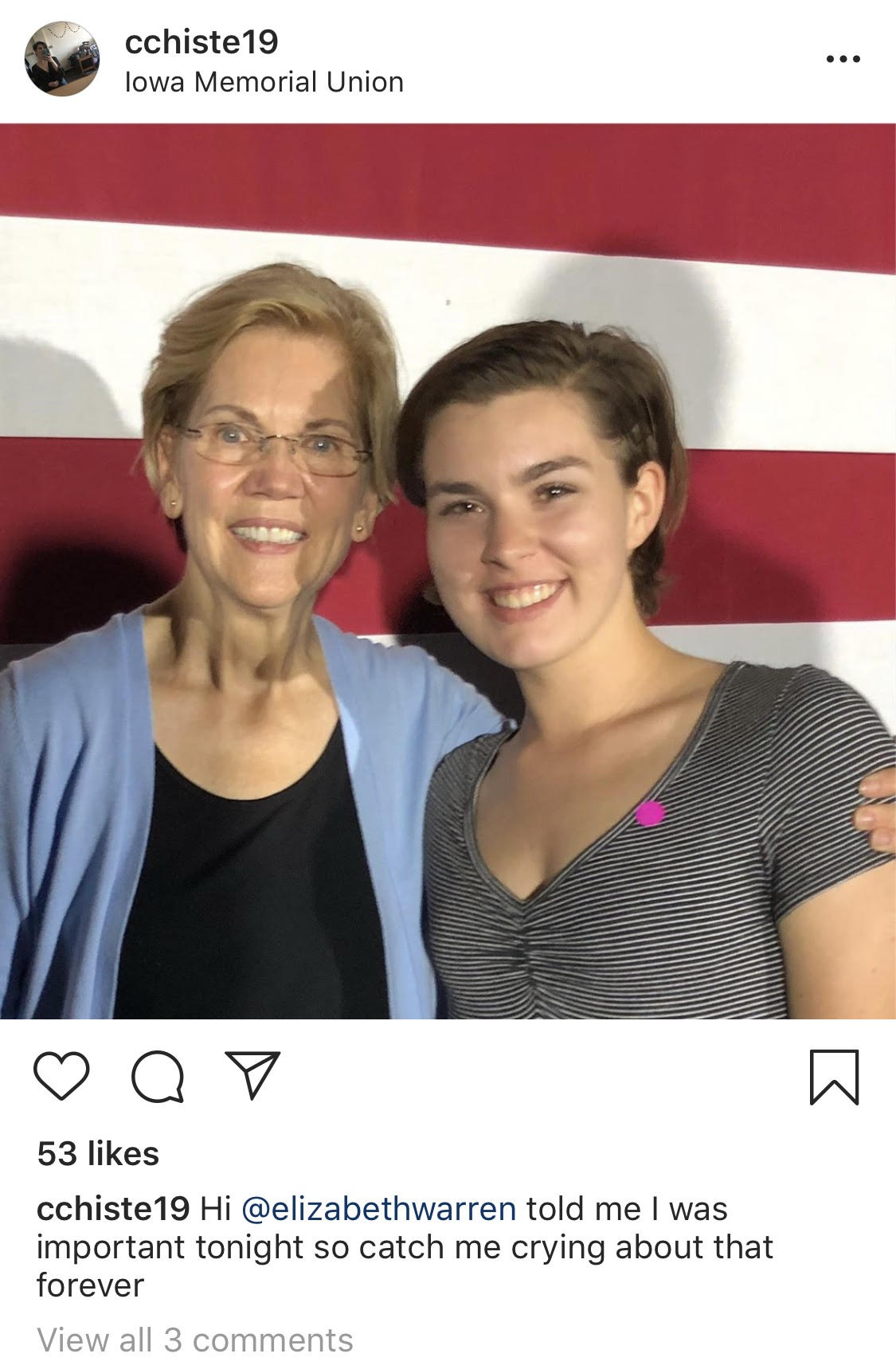
In late March, Jocelyn Roof, a sophomore at the University of Iowa, picked up a call from an unknown number and heard Senator Elizabeth Warren’s voice on the other end of the line. Warren asked her what got her “in this fight”—Roof said she was very concerned about income inequality—and thanked Roof for her $25 donation.
As soon as she got off the phone, Roof took a selfie of her shocked face. She posted it to Snapchat with the caption “MY WHOLE LIFE WAS MADE,” then screenshotted it and posted it to Twitter. Warren retweeted the selfie, with the comment “I’m so glad we got to talk!”
Before the call, Roof said she was undecided about who she would support in the Iowa caucuses. Afterwards, her enthusiasm for Warren “skyrocketed,” she says. “I couldn’t imagine voting for anyone else.” She started donating $5 to the campaign every month and buying snacks for volunteers at field offices. In the first three weeks of September, she registered more than 1,000 new voters on her University of Iowa campus, independent of the Warren campaign.
On Sept. 20, Roof was wearing a “Women for Warren” shirt as she waited in line to take a selfie with the Senator after a rally on her campus. The call and the tweet had made a young undecided Iowa voter into an avid supporter, grassroots donor and potential volunteer.

Warren’s digital strategy depends on voters like Roof. It’s why she calls individual grassroots donors, often posting videos of the calls to social media after. It’s why she engages with individual supporters online. And it’s why she spends hours taking selfies after every event. Her campaign has prioritized building individual connections with specific voters, and—more importantly—creating tiny pieces of organic digital content that those grassroots supporters then blast to their own social media networks to express their support. On the day Roof stood in line to wait for her selfie with the Senator, Warren took her 60,000th selfie, according to the campaign.
“The selfie lines are a chance for people to get in a question, talk about issues that matter to them, or pass her a note they really want her to read,” says Warren spokeswoman Saloni Sharma. “We’re building a grassroots movement, person to person, face to face.”
Warren emerged at the top of the polls in Iowa for the first time in a new Des Moines Register/CNN poll Saturday night, which found that 22% of likely Democratic caucusgoers list her as their first choice, and 32% of voters who caucused for Bernie Sanders in 2016 plan to caucus for her.
Candidates snapping selfies with voters is not new. But Warren has elevated an old shtick into the centerpiece of her digital strategy. The Warren selfies are designed to be widely shared, and are particularly popular among younger voters who live most of their lives on social media. In interviews with supporters who waited in line to take selfies with Warren in Iowa on Thursday and Friday, most said they planned to post it on Instagram or Facebook, and a TIME review of their social media accounts suggests that they usually posted the photo almost immediately, where it quickly gained likes and comments.
The strategy seems tailor-made to address one of the most vexing problems of Hillary Clinton’s campaign. In 2016, Clinton supporters—often dogged by online harassment from accounts supporting Sanders or Donald Trump—would congregate in “secret” Facebook groups to discuss their candidate privately among people who they knew wouldn’t judge them. Some Clinton supporters described posting publicly about their candidate as deciding to “come out,” knowing that they could face vitriol, both online and in person, for supporting Clinton. Pantsuit Nation started as a secret Facebook group for enthusiastic Clinton supporters; at its height it had more than 3 million members, all choosing to post about Clinton in a private group rather than their public feeds.
After meeting Warren at the University of Iowa, Cameron Chiste, a 20-year old student, posted a photo with the caption “Hi @elizabethwarren told me I was important tonight so catch me crying about that forever.” She said she plans to use the photo as her Christmas Card picture to get her family to vote for Warren. Noah Wick, also a student at the school, sent his Warren selfie to his Republican parents and posted it to his Instagram, where followers commented “my ideal ticket” and “Warren/wick 2020.”


“A big part of me posting social media is showing my friends how much I care,” says Wick, adding that he wants to “leverage my personal relationships” to get his friends involved with the Iowa caucus. “If I can bombard them with this stuff, maybe one more person will vote.”
The selfie line also allows Warren a simple vehicle for hearing from voters. Each selfie takes roughly thirty seconds, just enough time for each supporter to deliver the Senator a quick message, but not enough time to get into a conversation. “The selfie line creates the space for listening to people’s stories,” says Senator Zach Wahls, a 28-year old Iowa State Senator who introduced Warren at her speech on Friday. “Iowa’s a relational state. It might go a little farther here than elsewhere.”
Not everybody who took a selfie plans to post it. Some said they plan to simply share them among their family members, while others want the photo merely as a private keepsake in case Warren gets elected President.
Lauren Williams, a 19-year old sophomore at Cornell College, took a selfie with Warren after her event in Mount Vernon, Ia., on Saturday, but said she wasn’t planning on posting the photo until she was sure she would be caucusing for her. To Williams, posting the photo of them together could be read as an endorsement, something that would raise objections in her conservative community. “I could see myself posting this on Facebook and having a lot of negative interactions,” she says. “I’m not going to post a pic until I know that I do support her, and I’m ready to answer questions from everyone.”
But for Jocelyn Roof, the choice was obvious. She posted the photo on her Instagram almost immediately, referring to the Senator as “President Elizabeth Warren” in the caption. A day later, it was her profile picture on Twitter.
Correction, Sept. 23
The original version of this story misspelled the name of the Iowa State Senator. He is Zach Wahls, not Zach Wahl.
More Must-Reads From TIME
- The 100 Most Influential People of 2024
- The Revolution of Yulia Navalnaya
- 6 Compliments That Land Every Time
- What's the Deal With the Bitcoin Halving?
- If You're Dating Right Now , You're Brave: Column
- The AI That Could Heal a Divided Internet
- Fallout Is a Brilliant Model for the Future of Video Game Adaptations
- Want Weekly Recs on What to Watch, Read, and More? Sign Up for Worth Your Time
Write to Charlotte Alter/Iowa City at charlotte.alter@time.com
